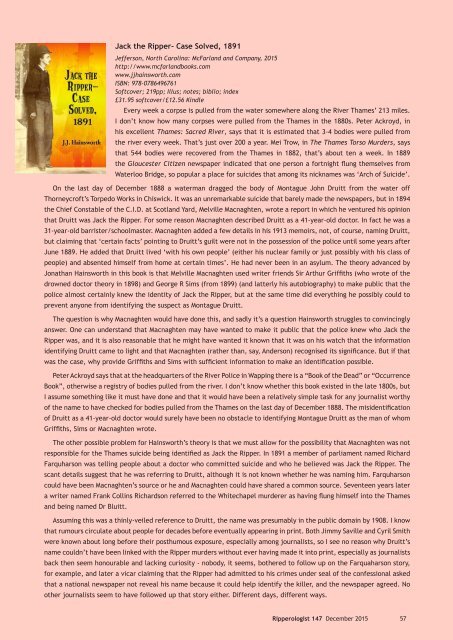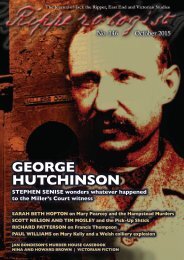Edmund Reid
nuhf574
nuhf574
You also want an ePaper? Increase the reach of your titles
YUMPU automatically turns print PDFs into web optimized ePapers that Google loves.
Jack the Ripper- Case Solved, 1891<br />
Jefferson, North Carolina: McFarland and Company, 2015<br />
http://www.mcfarlandbooks.com<br />
www.jjhainsworth.com<br />
ISBN: 978-0786496761<br />
Softcover; 219pp; Illus; notes; biblio; index<br />
£31.95 softcover/£12.56 Kindle<br />
Every week a corpse is pulled from the water somewhere along the River Thames’ 213 miles.<br />
I don’t know how many corpses were pulled from the Thames in the 1880s. Peter Ackroyd, in<br />
his excellent Thames: Sacred River, says that it is estimated that 3-4 bodies were pulled from<br />
the river every week. That’s just over 200 a year. Mei Trow, in The Thames Torso Murders, says<br />
that 544 bodies were recovered from the Thames in 1882, that’s about ten a week. In 1889<br />
the Gloucester Citizen newspaper indicated that one person a fortnight flung themselves from<br />
Waterloo Bridge, so popular a place for suicides that among its nicknames was ‘Arch of Suicide’.<br />
On the last day of December 1888 a waterman dragged the body of Montague John Druitt from the water off<br />
Thorneycroft’s Torpedo Works in Chiswick. It was an unremarkable suicide that barely made the newspapers, but in 1894<br />
the Chief Constable of the C.I.D. at Scotland Yard, Melville Macnaghten, wrote a report in which he ventured his opinion<br />
that Druitt was Jack the Ripper. For some reason Macnaghten described Druitt as a 41-year-old doctor. In fact he was a<br />
31-year-old barrister/schoolmaster. Macnaghten added a few details in his 1913 memoirs, not, of course, naming Druitt,<br />
but claiming that ‘certain facts’ pointing to Druitt’s guilt were not in the possession of the police until some years after<br />
June 1889. He added that Druitt lived ‘with his own people’ (either his nuclear family or just possibly with his class of<br />
people) and absented himself from home at certain times’. He had never been in an asylum. The theory advanced by<br />
Jonathan Hainsworth in this book is that Melville Macnaghten used writer friends Sir Arthur Griffiths (who wrote of the<br />
drowned doctor theory in 1898) and George R Sims (from 1899) (and latterly his autobiography) to make public that the<br />
police almost certainly knew the identity of Jack the Ripper, but at the same time did everything he possibly could to<br />
prevent anyone from identifying the suspect as Montague Druitt.<br />
The question is why Macnaghten would have done this, and sadly it’s a question Hainsworth struggles to convincingly<br />
answer. One can understand that Macnaghten may have wanted to make it public that the police knew who Jack the<br />
Ripper was, and it is also reasonable that he might have wanted it known that it was on his watch that the information<br />
identifying Druitt came to light and that Macnaghten (rather than, say, Anderson) recognised its significance. But if that<br />
was the case, why provide Griffiths and Sims with sufficient information to make an identification possible.<br />
Peter Ackroyd says that at the headquarters of the River Police in Wapping there is a “Book of the Dead” or “Occurrence<br />
Book”, otherwise a registry of bodies pulled from the river. I don’t know whether this book existed in the late 1800s, but<br />
I assume something like it must have done and that it would have been a relatively simple task for any journalist worthy<br />
of the name to have checked for bodies pulled from the Thames on the last day of December 1888. The misidentification<br />
of Druitt as a 41-year-old doctor would surely have been no obstacle to identifying Montague Druitt as the man of whom<br />
Griffiths, Sims or Macnaghten wrote.<br />
The other possible problem for Hainsworth’s theory is that we must allow for the possibility that Macnaghten was not<br />
responsible for the Thames suicide being identified as Jack the Ripper. In 1891 a member of parliament named Richard<br />
Farquharson was telling people about a doctor who committed suicide and who he believed was Jack the Ripper. The<br />
scant details suggest that he was referring to Druitt, although it is not known whether he was naming him. Farquharson<br />
could have been Macnaghten’s source or he and Macnaghten could have shared a common source. Seventeen years later<br />
a writer named Frank Collins Richardson referred to the Whitechapel murderer as having flung himself into the Thames<br />
and being named Dr Bluitt.<br />
Assuming this was a thinly-veiled reference to Druitt, the name was presumably in the public domain by 1908. I know<br />
that rumours circulate about people for decades before eventually appearing in print. Both Jimmy Saville and Cyril Smith<br />
were known about long before their posthumous exposure, especially among journalists, so I see no reason why Druitt’s<br />
name couldn’t have been linked with the Ripper murders without ever having made it into print, especially as journalists<br />
back then seem honourable and lacking curiosity - nobody, it seems, bothered to follow up on the Farquaharson story,<br />
for example, and later a vicar claiming that the Ripper had admitted to his crimes under seal of the confessional asked<br />
that a national newspaper not reveal his name because it could help identify the killer, and the newspaper agreed. No<br />
other journalists seem to have followed up that story either. Different days, different ways.<br />
Ripperologist 147 December 2015 57




